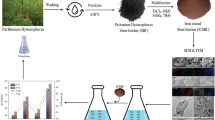Abstract
In this work, nanoporous hydroxyapatite (nano-HA) was synthesized and used as adsorbent for extraction of tetracyclines (TCs) in complex matrices. Owing to its permanent nanoscale porosity and surface functional groups on nano-HA, nano-HA has the potential to be a two-functional adsorbent to extract TCs as well as exclude macro-molecules such as protein in matrices. Therefore, we developed a facile method for the analysis of TCs in complex matrices by coupling nano-HA extraction with high-performance liquid chromatography–diode array detection. The new method gave wide linear correlations for TC concentration ranging from 0.96 to 4000 μg kg−1 with detection limits of 0.29–1.67 μg kg−1. The proposed method was successfully applied to determine TCs in pig tissue. This nano-HA extraction technique is rapid, simple, cost-effective, and environmentally friendly and has the potential to extract TCs from other bio-matrices.






Similar content being viewed by others
References
Albert A (1953) Avidity of terramycin and aureomycin for metallic cations. Nature 172:201
Badillo-Almaraz VE, Flores JA, Arriola H, López FA, Ruiz-ramirez L (2007) Elimination of fluoride ions in water for human consumption using hydroxyapatite as an adsorbent. J. Radioanal Nucl Chem 271:741–744
Carretero V, Blasco C, Picó Y (2008) Multi-class determination of antimicrobials in meat by pressurized liquid extraction and liquid chromatography–tandem mass spectrometry. J Chromatogr A 1209:162–173
EEC Council Regulation (1990) Laying down a community procedure for the establishment of maximum residue limits of veterinary medicinal products in foodstuffs of animal origin. Off J Eur Communities 224:1–8
Ghasemi E, Sillanpăă M (2015) Magnetic hydroxyapatite nanoparticles: an efficient adsorbent for the separation and removal of nitrate and nitrite ions from environmental samples. J Sep Sci 38:164–169
Gu ZY, Chen Y, Jiang J, Yan XP (2011) Metal-organic frameworks for efficient enrichment of peptides with simultaneous exclusion of proteins from complex biological samples. Chem Commun 47:4787–4789
Janus AM, Faryna M, Haberko K, Rakowska A, Panz T (2008) Chemical and microstructural characterization of natural hydroxyapatite derived from pig bones. Microchim Acta 161:349–353
**g JQ, Cooper C, Ouki S (2002) Comparison of modified montmorillonite adsorbents. Part I: preparation, characterization and phenol adsorption. Chemosphere 47:711–716
Langmuir I (1918) The adsorption of gases on plane surfaces of glass, mica and platinum. J Am Chem Soc 40:1361–1403
Li YB, Tjandra W, Tam KC (2008) Synthesis and characterization of nanoporous hydroxyapatite using cationic surfactants as templates. Mater Res Bull 43:2318–2326
Lin KL, Pan JY, Chen YW, Cheng RM, Xu XC (2009) Study the adsorption of phenol from aqueous solution on hydroxyapatite nanopowders. J Hazard Mater 16:231–240
Pan X, Qiang ZM, Ben WW, Chen MX (2011) Residual veterinary antibiotics in swine manure from concentrated animal feeding operations in Shandong Province, China. Chemosphere 84:695–700
Polat H, Molva M, Polat M (2006) Capacity and mechanism of phenol adsorption on lignite. Int J Miner Process 79:264–273
Río JGD, Sanchez P, Morando PJ, Cicerone DS (2006) Retentionion of Cd, Zn and Co on hydroxyapatite filters. Chemosphere 64:1015–1020
Sandrine B, Ange N, Didier BA, Eric C, Patrick S (2007) Removal of aqueous lead ions by hydroxyapatites: equilibria and kinetic processes. J Hazard Mater 139:443–446
Schek RM, Wilke EN, Hollister SJ, Krebsbach PH (2006) Combined use of designed scaffolds and adenoviral gene therapy for skeletal tissue engineering. Biomaterials 27:1160–1166
Ulibarri MA, Pavlovic I, Hermosin MC, Cornejo J (1995) Hydrotalcite-like compounds as potential sorbents of phenols from water. Appl Clay Sci 10:131–145
Wang HL, Zhai LF, Li YH, Shi TJ (2008) Preparation of irregular mesoporous hydroxyapatite. Mater Res Bull 43:1607–1614
Yao J, Tjandra W, Chen YZ, Tam KC, Ma J, Soh B (2003) Hydroxyapatite nanostructure material derived using cationic surfactant as a template. J Mater Chem 13:3053–3057
Yildiz N, Kapucu H, Calimli A (2000) Response surface optimization of the phenol adsorption on to HDTMA-bentonite. Rev Chem Eng 16:55–70
Zhao RS, Wang X, Yuan JP, Zhang LL (2009) Solid-phase extraction of bisphenol A, nonylphenol and 4-octylphenol from environmental water samples using microporous bamboo charcoal, and their determination by HPLC. Microchim Acta 165:443–447
Zhao L, Dong YH, Wang H (2010) Residues of veterinary antibiotics in manures from feedlot livestock in eight provinces of China. Sci Total Environ 408:1069–1075
Funding
This work was partially supported by Technique Support Program of State Administration for Market Regulation (No. 2019YJ029).
Author information
Authors and Affiliations
Corresponding authors
Ethics declarations
Conflict of Interest
Qian Zhou declares that she has no conflict of interest. Hong Wang declares that she has no conflict of interest. Kuanzheng Zhu declares that he has no conflict of interest. Cong Yao declares that she has no conflict of interest. ** Peng declares that she has no conflict of interest. Yanming Chen declares that he has no conflict of interest. Shengyin Zhou declares that he has no conflict of interest. Lihua Zhu declares that she has no conflict of interest.
Ethical Approval
This article does not contain any studies with human participants or animals performed by any of the authors.
Informed Consent
Not applicable
Additional information
Publisher’s Note
Springer Nature remains neutral with regard to jurisdictional claims in published maps and institutional affiliations.
Electronic supplementary material
ESM 1
(DOCX 215 kb)
Rights and permissions
About this article
Cite this article
Zhou, Q., Wang, H., Zhu, K. et al. Evaluation of Hydroxyapatite as Adsorbent in the Analysis of Trace Tetracyclines in Complex Matrices. Food Anal. Methods 14, 28–35 (2021). https://doi.org/10.1007/s12161-020-01858-5
Received:
Accepted:
Published:
Issue Date:
DOI: https://doi.org/10.1007/s12161-020-01858-5




